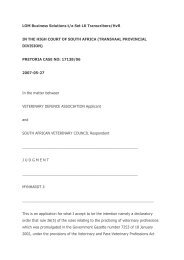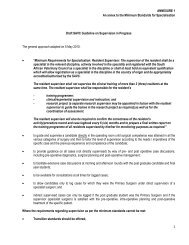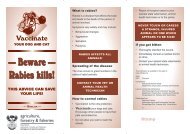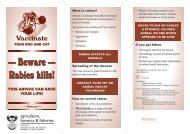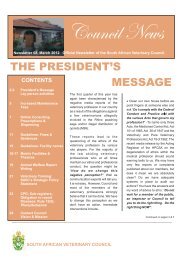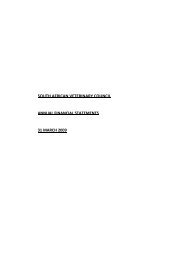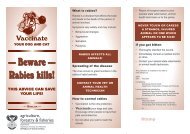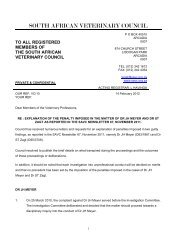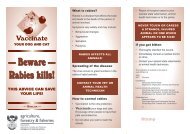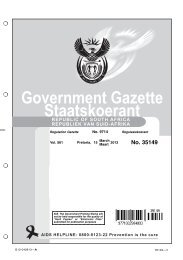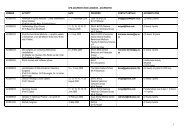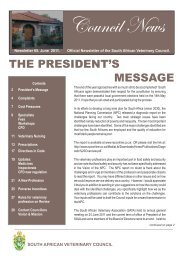Rabies Guide 2010.pdf - the South African Veterinary Council
Rabies Guide 2010.pdf - the South African Veterinary Council
Rabies Guide 2010.pdf - the South African Veterinary Council
Create successful ePaper yourself
Turn your PDF publications into a flip-book with our unique Google optimized e-Paper software.
disease control if <strong>the</strong>y suspect that <strong>the</strong> animal had<br />
rabies or a positive test result is received.<br />
The fluorescent antibody test (FAT) is <strong>the</strong> standard<br />
diagnostic test currently used in <strong>South</strong> Africa, and<br />
elsewhere. 164 The presence of rabies virus antigen<br />
is demonstrated in brain smears by means of<br />
immunofluorescence using antirabies fluorescein<br />
conjugate. The FAT is more than 99% reliable in<br />
experienced hands. The conjugate produced by <strong>the</strong><br />
<strong>Rabies</strong> Unit at ARC-OVI will also detect rabiesrelated<br />
virus antigen. (Personal communication,<br />
Claude Sabeta). Commercial conjugates are also<br />
available.<br />
Supplementary tests used include cell culture, mouse<br />
inoculation, <strong>the</strong> polymerase chain reaction and<br />
immunohistological tests. Histopathology, which<br />
makes use of formalin-impregnated brain sections, is<br />
not always informative for rabies infection but may<br />
help to exclude conditions in <strong>the</strong> differential diagnosis<br />
of rabies. 39<br />
The FAT can be completed within 2 hours of receiving<br />
suitable brain material and delays in obtaining<br />
laboratory results are usually due to transportation<br />
problems. 21,30 Because post-exposure prophylaxis of<br />
humans should be instituted without delay, decisions<br />
on <strong>the</strong> correct course of action are usually taken<br />
before <strong>the</strong> results of veterinary diagnostic tests become<br />
available. However, <strong>the</strong> results of laboratory tests<br />
are used, in conjunction with <strong>the</strong> clinical history,<br />
to decide whe<strong>the</strong>r antirabies prophylaxis should be<br />
continued or discontinued.<br />
Differential diagnosis<br />
<strong>Rabies</strong> must be considered in <strong>the</strong> differential diagnosis<br />
of any suspected mammalian encephalitis. Various<br />
conditions that have been confused with rabies are<br />
listed in Table 8. 18,40<br />
24



